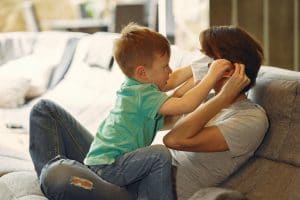In these changing times, due to COVID-19, we have had to change our behaviour in a lot of uncomfortable ways. We’ve done this to follow the rules and recommendations set out by the government and public health officials. The field of Applied Behaviour Analysis has a lot to offer to help!
One of the recommendations is the wearing of masks while out in public where physical distancing isn’t possible. Wearing masks may be uncomfortable and foreign to most adults. Parents of autistic children have been particularly concerned with how to get their children to safely and effectively wear masks.
Parents of children that have sensory issues already know how the struggle of the basics such as underwear and socks! Now with the expectations of wearing masks, there is the introduction of yet another stressor (for both child and parent!).
Create a plan based in Applied Behaviour Analysis:
Developing a plan to help desensitize your child to masks is essential. It is best to work with your therapy team to ensure you are taking the right steps for your child.
As changes in routine can be more difficult for children on the spectrum, I am providing you with these guidelines as a starting point.
If you don’t have a therapy team, feel free to reach out to Side by Side Therapy for a no-charge consultation.
Here are 3 helpful tips to encourage mask wearing:
Make your Expectations Clear
Explaining to your child what you expect regarding mask-wearing will help to clearly outline what needs to happen and why. It may be helpful to use the “If-Then” or “First-Then” language approach. For instance, “If you want to go outside, then you have to wear your mask”. “First we put your mask on, then we can go to the store”.

Reinforcement and Praise
One of the foundations of ABA is reinforcement. Since wearing a mask is a huge accomplishment for your autistic child, it’s important to provide tons of reinforcement and praise. This will help make wearing a mask as motivating as possible. A few suggestions are:

- Purchase a mask that has a preferred character or personalized touch on it.
- Provide a favourite reward for wearing the mask for the agreed-upon time. Remember, start slow so you can work to build up your child’s tolerance.
- Initially, you could have your child wear the mask while doing their favourite activity, such as playing on their iPad or Lego.
- When you have your first practice run in public you should do something fun! Going to your child’s favourite place or visiting loved ones are great ideas.
Work on your child’s mask tolerance
Mask tolerance is going to be a challenge for a lot of autistic children and it is necessary to make the experience as fun and pleasant as possible. This can all start with having your child, pick out their own material or mask while paying special attention to their sensory needs. Once you have chosen a mask that you feel will be appropriate for your child, your next step is to create a plan of action for introducing and then successfully wearing the mask.
The field of applied behaviour analysis suggests adopting three strategies to help in the desensitization of mask-wearing: Pairing, Shaping and Chaining. Read more about ABA terms and meanings.
Pairing
Pairing is a way that introduces unfamiliar objects, in this case a face mask, to a person. Present the unfamiliar object at the same time as a preferred object and the pleasant qualities of the preferred object are transferred to the unfamiliar one. To make the mask seems fun and welcoming present it to your child at the same time as you give reinforcers. It can take many presentations before the unfamiliar object becomes ‘paired’ with the preferred one. Once your child becomes comfortable holding it, it is then time to introduce shaping.
Shaping
Shaping takes place once your child has become familiar and comfortable with the mask, and at this time, you can then, using the same positive reinforcers, have your child begin to gradually engage more and more with the mask. For example the process in a shaping procedure for mask wearing might be to:

- Hold the mask;
- Bring the mask close to their face;
- Then touch the mask to their face;
- Allow you to pull back the elastic bands or bring the ties around to the back of their head;
- Fitting the mask to their head. This piece may need to be started in very short increments. You may want to use a visual timer to help cue your child to how much time is left.
After your child engages in each step without challenging behaviour you need to reinforce their efforts. This may seem easy and straightforward but it may take some practice and many trial runs before success is achieved. As you know, practicing and learning a new skill takes patience, so too will becoming comfortable with mask-wearing. Be sure to initially practice pairing and then shaping at home or in a safe environment and once the comfort level is achieved you can try it out in public. And remember, your ABA therapist is always available to guide you and provide you with the resources you need to help manage this challenging situation.
Chaining
Chaining is the idea of putting a number of behaviours together to create a sequence (or chain). In this example, a chain for mask wearing would include washing hands before putting the mask on, securing the mask to the head, wearing the mask, removing it safely, putting it in the trash or washing machine and washing hands again.
Chaining is a helpful way of teaching complex behaviours that happen in a specific order each time.
As wearing a mask can be difficult and uncomfortable in general, the challenge, unfortunately, may become magnified for those that have sensory challenges such as autistic children. Therefore, it is important to work with your therapy team to come up with a plan and strategies to help your child manage successfully wearing a mask.
The content in your articles are so specific yet still easy to comprehend.
Much appreciated!